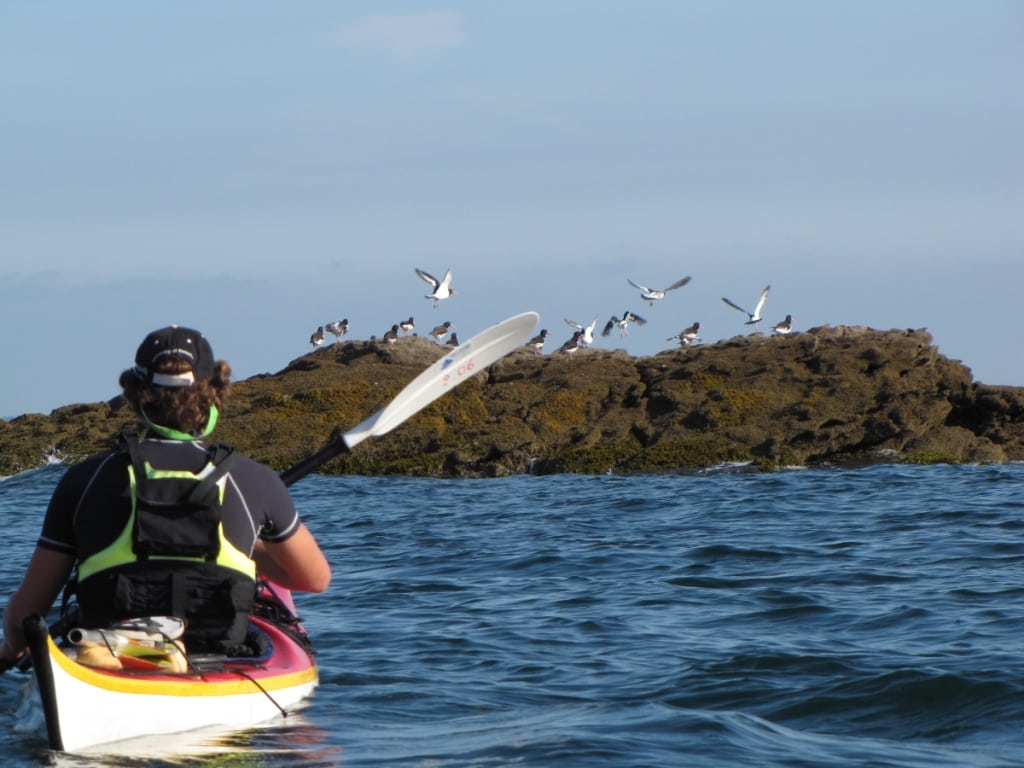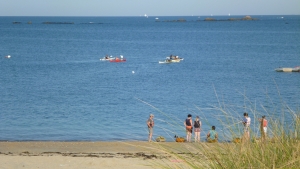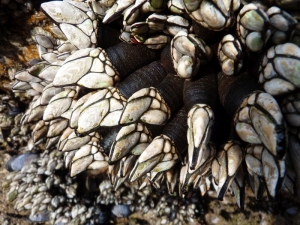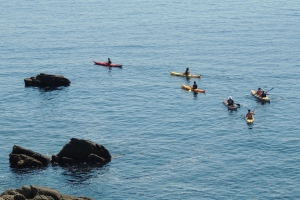FIRST EXPERIENCE
A strange boat for talking to the seabirds !
Fort Penthièvre, the ancient guardian of the wild west coast of the Quiberon peninsula, lifts its grey walls against a clear blue sky. Nearby, on the little beach of Saint Joseph de l’Océan, the pupils of a specialist school gather, in both summer and winter alike, at the Sea Kayak School of Saint-Pierre Quiberon, SILLAGES.
Sunday, September 1st. Three of us prepare to launch ourselves into what looks like a real adventure, braving the open sea in a frail kayak. Today there is a spring tide, the sea has gone out further than usual and the landscape is superb. The water is calm, with barely a ripple. “The ideal conditions for beginners,” Eric, our instructor assures us. “Just wait and see; it’s much easier than people think. You’ll soon feel at home.” The kayaks weigh about twenty kilos each. They can be carried, fairly easily, down to the water’s edge. Before getting aboard, the basics are explained. We learn how to stretch out our legs and slide into the narrow craft, brace ourselves against the back-rest and adjust our footrests. Then, three paddles are swung upwards ready for Eric’s instructions.
Lesson 1: how to hold the paddle correctly.
Lesson 2: learning the automatic flick of the wrist, like revving a motorbike, twisting the paddle a quarter turn between each stroke. This is because the two blades are not on the same plane, so as to reduce air resistance.
Lesson 3: turning left, turning right, and reversing. Ready? Slip on the splash deck, the kayaker’s best friend, a waterproof cover with one elastic strap around the top to hold it up around your chest and one at the bottom to snap around the kayak’s opening. Not a drop gets past it, unless you turn completely turtle in the breakers. A lifejacket on top, a quick push with your hands to set the kayak afloat and you’re off!
Miraculous! For my first experience, I was expecting to roll from side to side, but the boat goes straight ahead and is amazingly stable. Eric has us do a few turns, constantly checks the position of our hands and corrects our movements: straighten your upper arm, reach well forward with each stroke. Like with skiing, it’s best to learn good habits from the start.
The wild coast of Quiberon, one of the finest seascapes in the world, opens up before us. We’re already skimming past the first rocks. The water is crystal clear. Just below the surface sway the extraordinarily long broad strands of kelp, seaweed which never grows inshore. In places, the rocks seem to brush past us, but we glide by! With a draft of only eight inches, we can get away with a lot.
I’ve never seen the coast from this angle before. From the cliff-tops you look down onto the rocks. From sea-level, what a difference there is! Some cliffs rise like golden-grey walls, sparkling in the sunlight, criss-crossed with deep crevices, their base carpeted by serried ranks of black mussels. Further along, pollicipes cornucopia clings to the rocky walls. These strange, rare, inaccessible and therefore much prized shellfish only make their home on the most exposed rocks.
We slip silently between the reefs. We can hardly hear the gentle plash of the paddles dipping into the water; it’s too quiet to disturb the gulls perched here and there. We literally pass right beneath their beaks as they watch us red-eyed, not moving a feather. We are witnesses to their fishing expeditions; a few starfish bearing the brunt of it. We simply seem to be some peaceful sea creatures, familiar and inoffensive, not even competing with them for food. No other vessel gives you this magical sensation of being one with the craft. You are a fish, a merman, weightless. You melt into the seascape.
Already totally won over, we become familiar with the manoeuvres. Before long we can judge the width of the narrowest gaps – two feet is enough. We explore “Rividi Braz, and Rividi Bihan” (on the Breton coast, the smallest pebble has its own name); we round the “Percho” headland, paddling off a length to admire the leonine profile of the “Rocher du Lion”; we thread our way into the clefts and the deep caves that abound all along the wild coast, undreamt-of from the cliffs above. Here the rocks take on extraordinary colours – pink, scarlet, purple… For a short break, we go ashore on the pretty beach at “Port Blanc”, amid the smiling bathers.
The time goes by quickly, too quickly. We have to think about getting back. As the tide rises, so do the waves, and this time I don’t think I’ll escape a dipping. Never mind! I follow Eric’s advice to the letter: always attack the waves head on, paddling vigorously… and the slender prow of my beautiful kayak cuts right through the wave, smoothly clearing it without even a splash.
The only reason we get wet at all is that Eric feels we’re much too dry for novices, and sprays us with a flick of his paddle!
We approach the pretty, natural harbour of Portivy. In the distance behind Fort Penthièvre stretches the bright continuous outline of the Plouharnel and Erdeven beaches. Before landing in the cove where we began, we aim for “Karreg Lagalas”, a rocky sun-washed islet echoing with the song of seabirds. Black and white plumage, long slightly red beak – it’s a magnificent colony of Pied Oyster-Catchers!
The excursion has lasted three hours. Admittedly, we can feel that our shoulders have had a little work-out, but our eyes are full of the fabulous sights and our lungs full of the fresh sea air. We only have one thought in mind – DOING IT ALL AGAIN !









